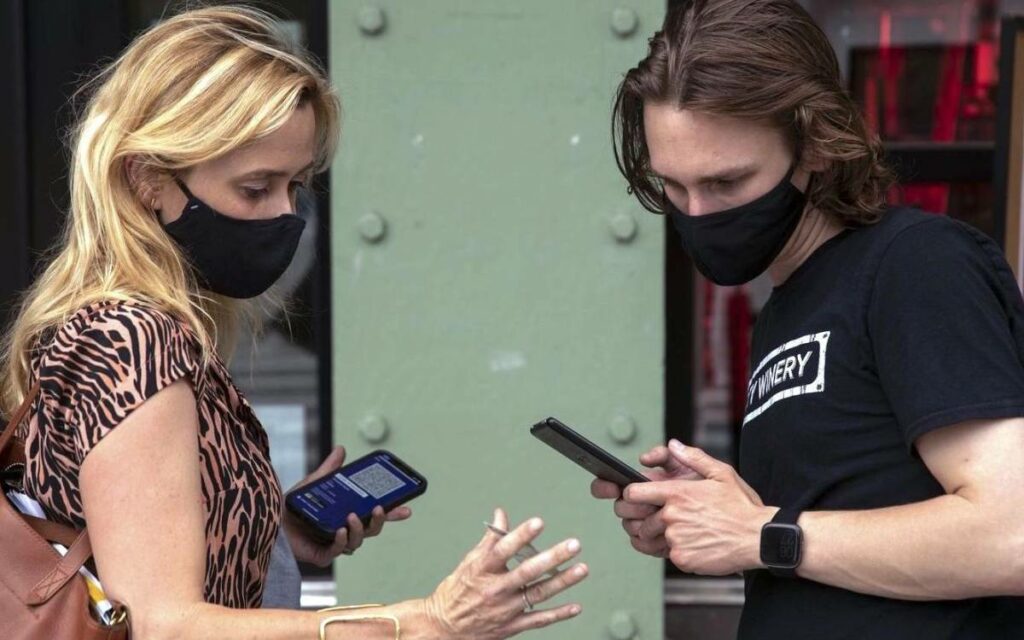
A customer presents proof of vaccination to enter a restaurant. Photo credit: New York Times/Victor Blue
What might have been missed in the election fervor is that on September 14, 2021 the Ontario government released the regulations (Reg 645/21) and guidance for businesses and organizations to support them in implementing proof of vaccination requirements, taking effect September 22, 2021.
The proof of identification and proof of vaccination against COVID-19 requirements under Reg. 364/20: Rules for Areas at Step 3 and at the Roadmap Exit Step under Reopening Ontario (A Flexible Response to COVID-19) Act, 2020 (the “ROA”) apply only to patrons seeking to enter the prescribed indoor areas of the non-essential businesses/organizations under section 2.1 of Schedule 1 of Reg. 364/200, with exceptions for certain activities (e.g., paying, picking up take-out, and using the restrooms). Please reference my previous article for the list.
These requirements do not apply to the employees, contractors, repair workers, delivery workers, students, volunteers (e.g., coaches and officials), inspectors, or others when entering such business/organizations for business or work purposes.
The Guide sets out each parties’ responsibilities and the consequences of non-compliance. Specifically, to gain entrance to such businesses/organizations, with limited exceptions:
– Step 1: Patrons, including those visiting Ontario, must provide requisite proof of:
(1) Identification (e.g., birth certificate, citizenship card, driver’s licence, Government (Ontario or other) issued identification card, including health card, Indian Status Card /Indigenous Membership Card, Passport, or Permanent Resident card). The burden of proof for each rests solely on the patron; and
(2) Full vaccination to COVID-19 – or a documented exemption. Failure to comply, including obstructing any person exercising a power or performing a duty (including workers) in accordance with Reg.364/20 can result in charges under the ROA. If prosecuted under Part I of the Provincial Offenses Act (POA), set fine amounts are $750 for individuals and where prosecuted under Part I or Part II of the POA maximum penalties include fines of up to $100,000 and up to a year in jail for an individual.
– Step 2: Businesses/organizations that the patron seeks entry to must review and confirm such proof, including:
(1) Matching the patron’s name and date of birth (i.e., the two key identifiers being used) on both their identification document and their vaccination receipt; and
(2) Confirming that the person is fully vaccinated – including ensuring that the required immunization period has been achieved (i.e., second dose administration date plus 14 days) – or have a documented exception.
If the name and date of birth on both documents do not match, no entry is permitted.
Businesses/organizations are responsible for compliance with each of these requirements. Noon-compliance can result in charges under the ROA. If charged under Part I of the POA, set fine amounts are $1,000 for corporations. If prosecuted under Part I or Part II of the POA, maximum penalties include fines of up to $500,000 and up to a year in jail for an individual who is a director or officer of a corporation; and up to $10 million for a corporation.
Where patrons claim a medical exemption, the patron must provide a written document:
- Completed and supplied by 1 of 3 classes of medical professionals: (a) “MD”; (b) Registered Nurse (Extended Class); or (c) Nurse Practitioner; and
- Stating: (a) that the individual is exempt for a medical reason; and (b) the effective time-period for the medical reason.
In turn, to review proof of a medical reason, the business/organization must ensure two things:
(1) The name of the person in the written documentation matches the identification provided; and
(2) The stipulated medical professional’s information is “complete” – meaning its includes:
o Name and contact information of the required medical professional;
o Logo or letterhead identifying the requisite medical professional;
o Statement that there is a medical reason for the individual’s exemption from being fully vaccinated against COVID-19; and
o Any effective time-period for the medical reason, which must cover the date the patron seeks entry.
Meaning if incomplete the patron must be denied entry.
No mention is made in the Guide regarding the potential – yet so far elusive – religious exemption.
Employers and employees alike must be prepared and knowledgeable on these requirements and what is expected of them so that they are able to consistently and effectively apply these proof of identification and proof of vaccination against COVID-19 requirements commencing Wednesday.

Sheryl L. Johnson brings a proactive, creative, and vibrant attitude to her labour, employment and human resource law practice. Sheryl has extensive experience in representing clients in both the provincial and federal jurisdictions on all matters relating to employment and labour law, including for example construction labour law, employment related civil wrongful dismissal, human rights, and labour board litigation; privacy, governance, statutory and regulatory compliance, and executive compensation matters; as well as conducting workplace training and workplace investigations. Sheryl is also an avid educator and writer, including authoring a bi-weekly business column in The Niagara Independent and the text: Sexual Harassment in Canada: A Guide for Understanding and Prevention. Sheryl enjoys in her free time giving back to the Niagara community. She is a member of the WIN Council, Chair of the Board of Directors for the Niagara Jazz Festival, Vice-President of the Board of Directors for the YWCA Niagara Region, Secretary of Big Brothers Big Sisters of Niagara Falls Board of Directors, a board member of the Niagara Home Builders Association, and a board member of the Women in Construction group of the Niagara Construction Association.




















